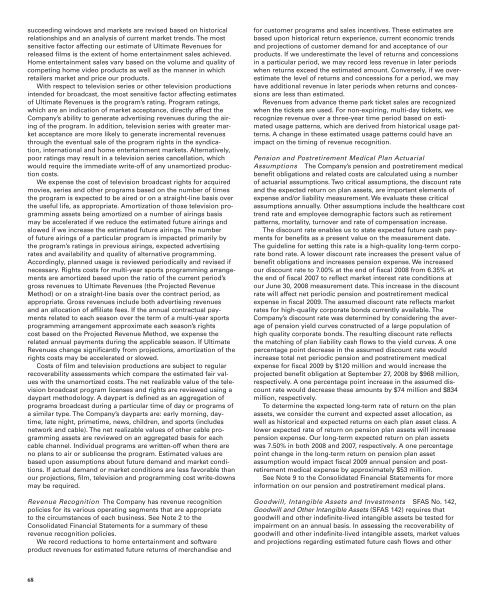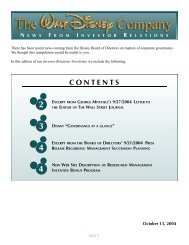Disney - The Walt Disney Company
Disney - The Walt Disney Company
Disney - The Walt Disney Company
Create successful ePaper yourself
Turn your PDF publications into a flip-book with our unique Google optimized e-Paper software.
succeeding windows and markets are revised based on historical<br />
relationships and an analysis of current market trends. <strong>The</strong> most<br />
sensitive factor affecting our estimate of Ultimate Revenues for<br />
released films is the extent of home entertainment sales achieved.<br />
Home entertainment sales vary based on the volume and quality of<br />
competing home video products as well as the manner in which<br />
retailers market and price our products.<br />
With respect to television series or other television productions<br />
intended for broadcast, the most sensitive factor affecting estimates<br />
of Ultimate Revenues is the program’s rating. Program ratings,<br />
which are an indication of market acceptance, directly affect the<br />
<strong>Company</strong>’s ability to generate advertising revenues during the airing<br />
of the program. In addition, television series with greater market<br />
acceptance are more likely to generate incremental revenues<br />
through the eventual sale of the program rights in the syndication,<br />
international and home entertainment markets. Alternatively,<br />
poor ratings may result in a television series cancellation, which<br />
would require the immediate write-off of any unamortized production<br />
costs.<br />
We expense the cost of television broadcast rights for acquired<br />
movies, series and other programs based on the number of times<br />
the program is expected to be aired or on a straight-line basis over<br />
the useful life, as appropriate. Amortization of those television programming<br />
assets being amortized on a number of airings basis<br />
may be accelerated if we reduce the estimated future airings and<br />
slowed if we increase the estimated future airings. <strong>The</strong> number<br />
of future airings of a particular program is impacted primarily by<br />
the program’s ratings in previous airings, expected advertising<br />
rates and availability and quality of alternative programming.<br />
Accordingly, planned usage is reviewed periodically and revised if<br />
necessary. Rights costs for multi-year sports programming arrangements<br />
are amortized based upon the ratio of the current period’s<br />
gross revenues to Ultimate Revenues (the Projected Revenue<br />
Method) or on a straight-line basis over the contract period, as<br />
appropriate. Gross revenues include both advertising revenues<br />
and an allocation of affiliate fees. If the annual contractual payments<br />
related to each season over the term of a multi-year sports<br />
programming arrangement approximate each season’s rights<br />
cost based on the Projected Revenue Method, we expense the<br />
related annual payments during the applicable season. If Ultimate<br />
Revenues change significantly from projections, amortization of the<br />
rights costs may be accelerated or slowed.<br />
Costs of film and television productions are subject to regular<br />
recoverability assessments which compare the estimated fair values<br />
with the unamortized costs. <strong>The</strong> net realizable value of the television<br />
broadcast program licenses and rights are reviewed using a<br />
daypart methodology. A daypart is defined as an aggregation of<br />
programs broadcast during a particular time of day or programs of<br />
a similar type. <strong>The</strong> <strong>Company</strong>’s dayparts are: early morning, daytime,<br />
late night, primetime, news, children, and sports (includes<br />
network and cable). <strong>The</strong> net realizable values of other cable programming<br />
assets are reviewed on an aggregated basis for each<br />
cable channel. Individual programs are written-off when there are<br />
no plans to air or sublicense the program. Estimated values are<br />
based upon assumptions about future demand and market conditions.<br />
If actual demand or market conditions are less favorable than<br />
our projections, film, television and programming cost write-downs<br />
may be required.<br />
Revenue Recognition <strong>The</strong> <strong>Company</strong> has revenue recognition<br />
policies for its various operating segments that are appropriate<br />
to the circumstances of each business. See Note 2 to the<br />
Consolidated Financial Statements for a summary of these<br />
revenue recognition policies.<br />
We record reductions to home entertainment and software<br />
product revenues for estimated future returns of merchandise and<br />
68<br />
for customer programs and sales incentives. <strong>The</strong>se estimates are<br />
based upon historical return experience, current economic trends<br />
and projections of customer demand for and acceptance of our<br />
products. If we underestimate the level of returns and concessions<br />
in a particular period, we may record less revenue in later periods<br />
when returns exceed the estimated amount. Conversely, if we overestimate<br />
the level of returns and concessions for a period, we may<br />
have additional revenue in later periods when returns and concessions<br />
are less than estimated.<br />
Revenues from advance theme park ticket sales are recognized<br />
when the tickets are used. For non-expiring, multi-day tickets, we<br />
recognize revenue over a three-year time period based on estimated<br />
usage patterns, which are derived from historical usage patterns.<br />
A change in these estimated usage patterns could have an<br />
impact on the timing of revenue recognition.<br />
Pension and Postretirement Medical Plan Actuarial<br />
Assumptions <strong>The</strong> <strong>Company</strong>’s pension and postretirement medical<br />
benefit obligations and related costs are calculated using a number<br />
of actuarial assumptions. Two critical assumptions, the discount rate<br />
and the expected return on plan assets, are important elements of<br />
expense and/or liability measurement. We evaluate these critical<br />
assumptions annually. Other assumptions include the healthcare cost<br />
trend rate and employee demographic factors such as retirement<br />
patterns, mortality, turnover and rate of compensation increase.<br />
<strong>The</strong> discount rate enables us to state expected future cash payments<br />
for benefits as a present value on the measurement date.<br />
<strong>The</strong> guideline for setting this rate is a high-quality long-term corporate<br />
bond rate. A lower discount rate increases the present value of<br />
benefit obligations and increases pension expense. We increased<br />
our discount rate to 7.00% at the end of fiscal 2008 from 6.35% at<br />
the end of fiscal 2007 to reflect market interest rate conditions at<br />
our June 30, 2008 measurement date. This increase in the discount<br />
rate will affect net periodic pension and postretirement medical<br />
expense in fiscal 2009. <strong>The</strong> assumed discount rate reflects market<br />
rates for high-quality corporate bonds currently available. <strong>The</strong><br />
<strong>Company</strong>’s discount rate was determined by considering the average<br />
of pension yield curves constructed of a large population of<br />
high quality corporate bonds. <strong>The</strong> resulting discount rate reflects<br />
the matching of plan liability cash flows to the yield curves. A one<br />
percentage point decrease in the assumed discount rate would<br />
increase total net periodic pension and postretirement medical<br />
expense for fiscal 2009 by $120 million and would increase the<br />
projected benefit obligation at September 27, 2008 by $968 million,<br />
respectively. A one percentage point increase in the assumed discount<br />
rate would decrease these amounts by $74 million and $834<br />
million, respectively.<br />
To determine the expected long-term rate of return on the plan<br />
assets, we consider the current and expected asset allocation, as<br />
well as historical and expected returns on each plan asset class. A<br />
lower expected rate of return on pension plan assets will increase<br />
pension expense. Our long-term expected return on plan assets<br />
was 7.50% in both 2008 and 2007, respectively. A one percentage<br />
point change in the long-term return on pension plan asset<br />
assumption would impact fiscal 2009 annual pension and postretirement<br />
medical expense by approximately $53 million.<br />
See Note 9 to the Consolidated Financial Statements for more<br />
information on our pension and postretirement medical plans.<br />
Goodwill, Intangible Assets and Investments SFAS No. 142,<br />
Goodwill and Other Intangible Assets (SFAS 142) requires that<br />
goodwill and other indefinite-lived intangible assets be tested for<br />
impairment on an annual basis. In assessing the recoverability of<br />
goodwill and other indefinite-lived intangible assets, market values<br />
and projections regarding estimated future cash flows and other

















